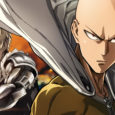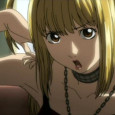I’m going to throw a tantrum if people don’t watch Kyousougiga.
I reviewed Kyousougiga a few weeks ago; now six episodes and halfway through the season later I’m still head over heels with it, but am baffled at why it is not catching on as much as I would like. It seems to be simmering under the radar and I really, really would like to change that. In my opinion it’s one of if not the best anime that has made a “Fall” debut in what is considered a generally “strong” season this year. And it disappoints me to see something bursting with creativity not getting the attention it should be getting.
Therefore here is a second set of points and arguments for you on why you should watch it aka why-you-need- to-watch-it-so-Max-stops-complaining-thanks-and-goodbye:
– Gorgeous animation ranging from subtle to overt graphic styling and effects and great use of CG; there is occasional “pop” styling for more energetic scenes and comedy but otherwise it is rather lush with well thought-out color palettes and lighting for more serious and poignant scenes. The animators like to show off. A LOT. Lighting and seasonal depictions, particularly snow, are well done and frequent. Very cinematic with elements of mono no aware it’s a bit slower than most anime and features some rather spectacular composition and framing as well as unique camera angles, camera wobbles and use of space. It’s more “mature” than your average anime even some of the very glossy ones this fall season if that makes any sense. Fight scenes too are impeccably choreographed.
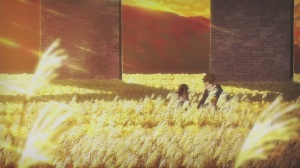

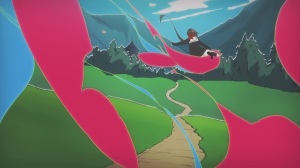
– Awesome symbolism, mostly Buddhist and Shinto philosophies, Japanese (and perhaps a dash of Greek) myth and folklore as well as heavy floral and fruit symbolism. It also carries literary influence from Alice’s Adventures in Wonderland/ Through The Looking Glass. While most series who attempt the Wonderland (or rather more so in this case Through the Looking Glass) inspiration or adaptation; Kyousougiga is unique in that it handles it extremely subtly instead of so on the nose as most tend to do.
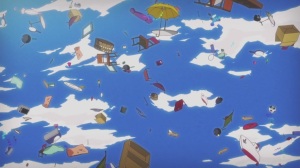
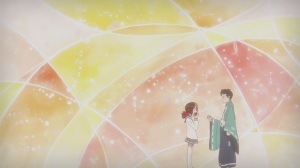

– It’s a non-moe and generally fan-service free series with well rounded characters. I actually don’t like a lot of anime anymore purely because the characters are too klutsy, too air-headed, or too inept all in the sake of being cute. It works in Nichijou but that is so heavily slapstick it makes sense. I otherwise like having some degree of range. For instance characters in the current fall favorite Kyoukai no Kanata, the leads are somewhat characterized by their weird quirks and fetishes, it’s all sort of a turn off for me. They feel somewhat, stunted for lack of a better term; something off that stops them from feeling organic or as round as they should. They “feel” like anime. Here, the characters feel more organic. The teenage lead Koto is tomboyish, nonsexualized and acts like a real teenager for the most part with shades of Haruko from FLCL. This goes for all of the characters; most have very round characterization with some pretty deep and serious themes and fall short of stepping over that line of tropes that most series take which oversimplify people into caricature.

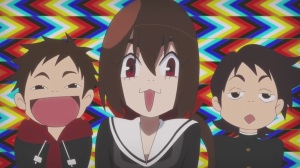
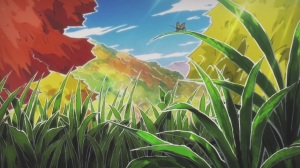
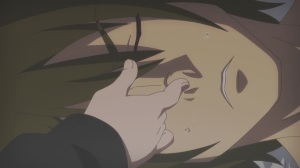
– Jigsaw-plot storytelling. This MAY be why people aren’t giving it a chance but I think this is why it is so great. It takes its sweet time to develop characters and reveals plot and back story in an advent calender style manner. This series starts at their 0 episode in media res with a FLCL Gainax-esque mind-screw of an episode that ends with the return of the character Lady Koto to the Mirror World. So far as of episode 6 each subsequent episode has not taken place past the ending to 0. They’ve been mostly nonconsecutive (though some parts are chronological) back story, flashbacks to incidents that came before or led up to that moment, or revisiting moments from 0 episode with a slightly altered perspective or less abstract manner, often showing more details not previously shown before or flat out showing something different. Essentially it’s a “How we got here” approach. While confusing at times things do rather neatly fall into place as things are explained and motifs seen before but not really touched on suddenly have meaning and that add further depth to the series as a whole. The repetition of certain scenes also adds a certain stylistic rhythm that I find interesting. When we move on past the ending of episode 0 I feel the series energy will really pump up with even more action.
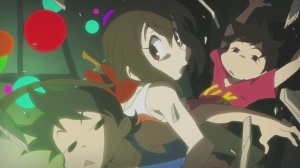
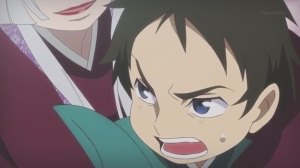
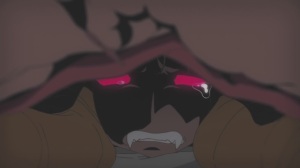
– Amazing writing. The plot is fresh and different than the norm and while it adheres to tropes it avoids a lot of common ones anime series can slather onto characters (coughKyoukai no Kanatacough). Family and what constitutes family is a big component and there are some actual pretty dark elements despite its occasional manicness. And yet the balance of comedy, general heartfelt exposition and then action against really heavy themes, is all really well done. As said before all the characters are very relatable and interesting; very round and weighty but that doesn’t mean they aren’t ridiculous either. Also as stated its inspiration from Lewis Carroll is done very subtly. Also, before I forget one little thing. YOU WILL CRY. This series is highly emotional especially if parent-child relationships strike a chord with you. And siblings. And just….everything. It’s very very touching and just beautifully done.
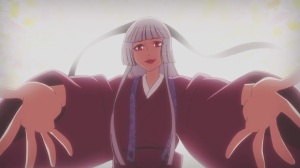
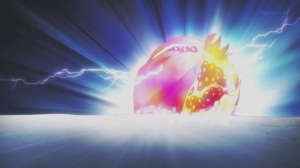
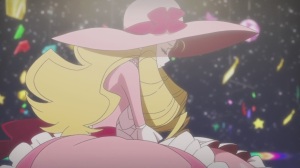
– Beautiful OST. Just. Listen. Okay. Trust. Me (this one will….hurt).
Just everything about it is really well done. So this is my second appeal. Watch this series, halfway through it’s still good and not losing steam. It’s totally free up over at Crunchyroll and entirely worth your time (and tears).
See you guys real soon!
Max Eber
Twitter: @maxlikescomics
Seldom do I fall for a new anime series as hard as I have for Kyousougiga. Having missed viewing it for last week’s small round-up of newer more buzzed about anime series, this gem was sadly overlooked. And I must berate myself for having done so. Which means to atone for my mistake I must push this series and make everyone watch it. And you must. Because it is amazing. If you won’t I may just throw a fit.
Kyousogiga (京騒戯画 Kyōsōgiga, lit. Capital Craze Comic) is a new anime TV series continuing or rather revisiting where a short 5 episode original net animation series (ONA) created by the collective Izumi Todo and produced by Toei Animation in collaboration with Banpresto left off. The original ONA debuted in 2011 and periodically released into 2012. Each episode was rather short and is notably somewhat out of order and or digressional so as such details can be a bit tricky to understand and a great deal were simply world building shorts. The new TV series more or less continues what was covered in the original, expanding on the plot and themes more in depth since the episodes for the new TV series are twenty-five minutes long.
The story is very much influenced by Alice in Wonderland and Through The Looking Glass in fact the opening to the ONA is more or less a direct homage to the beginning of the former tale and the book itself appears in the lead’s belongings.
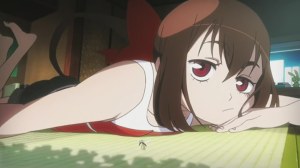
Koto
The series follows Koto, a fourteen year old girl who seems to belong to some sort of future quasi-military society or faction based in Kyoto called Shrine. The people of this faction seem to be gifted two spirit-like familiars that are rather puckish and have distinct personalities and are treated like family. Her guardian and mentor whose face is obscured with an Inari fox-mask (and is addressed as such by his familiars) talks to her about a mirror world and how he is sure one day she’ll be able to go there herself.

Eventually Koto and her two familiar “brothers” A and Un go looking for her mentor after he presumably left her behind and they run into a black, red eyed rabbit and go follow it; ultimately finding themselves in the Mirror World Inari was talking about, or rather, another Kyoto.
This Kyoto is a bizarre psychedelic and anachronistic jumbled world that rather like real Kyoto blends modernity with traditional elements side by side. Yokkai, ghosts, spirits and seemingly digital creations live alongside humans. Nothing can be destroyed here as things repair themselves and very few seem to age or get older. This realm is ruled by three siblings; an old temple priest Kurama who seems in charge of a science-y police force that has it’s own giant mecha, a hyper-feminine tea-drinking demon named Yase, and a young scooter riding Buddhist monk named Myoe. Why she is there and what she is to the three rulers of the world becomes a big part of the plot. Koto and her brothers settle in under Myoe’s care and cause trouble with a giant collapsible hammer she was given by her mentor.
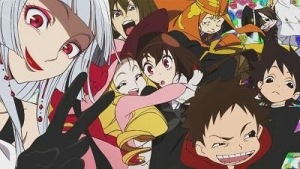

The series is also built on a beautiful, gentle fairytale of a back-story centered around the founding of the Mirror world and concerns the three sibling rulers and their parents; another monk also named Myoe whose illustrations would come to life and one of his creations the black rabbit goddess of the capital who is also named Koto. Both of whom are extremely relevant to the plot and after viewing the original ONA, you get a much better sense how Koto, and well Koto are actually connected.
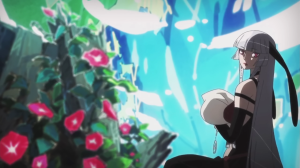
While there are many elements here that are on paper are not entirely original or have been seen and done many times before in different anime series, Kyousougiga seems to present them in a way that is fresh and exciting. The way they are presenting the narrative, often in media res or in incomplete flashbacks makes it fresh and interesting to watch as layers slowly peel away and connections are made amongst the mania. Often times details are purely visual and are cues that things there are connected to what comes later. When dealing with the three supernatural rulers things also get additionally trippy.
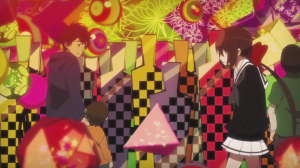
Kyousougiga however doesn’t anchor itself on its quirkiness and psychedelic visuals alone. It also has a strong emotional component to it concerning what constitutes a family and underlying themes centered around tolerance and prejudice. The original Myoe and Koto are faced with pressure from the local shrine priests and their intolerance of the monk’s eventual unconventional family causes them to flee to the Mirror Kyoto. Meanwhile our lead Koto is implied to be an orphan and adopted by her own mentor and is subtly discriminated against by other members of her community due to being an outsider and her having garnet-red eyes (something that is particularly important to note hint, hint). These emotional touches particularly the one revolving around family actually gives this manic series a greater advantage over any others that may have come before with similar plot-lines as they often lack the subtly and gentleness of the backstory and the messages that the series seems to be trying to make. Even the 7 minute fifth and final episode of the ONA packs an emotional wallop which gets revisited in the “second” TV series episode.
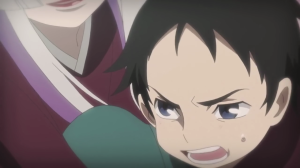
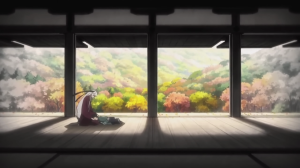
Visually the series is stunning, with beautiful art, cinematography and uses of CGI, interesting and varried character designs and great effects for both serious and comedic scenes. It’s experimentation in visual mediums and elements vaguely brings to mind works of Gainax, particularly FLCL which it at times matches in it’s manic-ness.

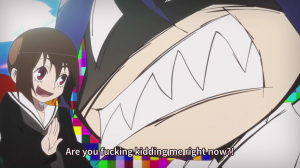
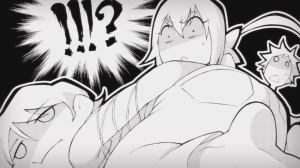
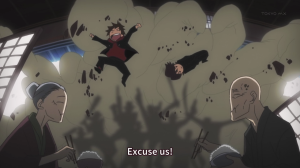
The series is also populated with gorgeous visuals with beautiful compositions found throughout and visual motifs that are more than just coincidence, mostly consisting of floral and vegetative symbolism. Recurring images such as pomegranates and morning glory pop up quite frequently. It is also heavily saturated in Japanese folklore and symbolism. The fact there is a rabbit heavily involved in the plot and our Koto carries a giant hammer is something that won’t go unnoticed if you are familiar with the Japanese rabbit in the moon tale.
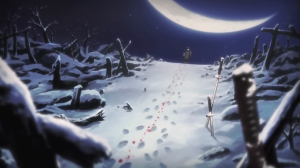
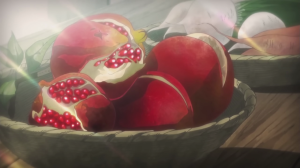
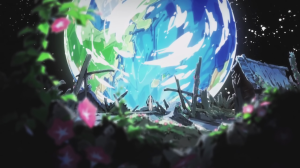
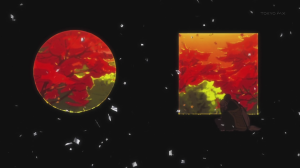
The jump from the ONA to the TV series amps the visuals and animation quality up even more and up through the roof. It’s clear they’ve been working on this for a long time. Look no further than the first TV episode which was originally a special; 00 “Introductory Chapter”“Yoshū-hen” (予習篇) for some of the coolest fight scenes from the get-go. Another element worth noting is that so far the TV series isn’t terribly fan-servicey either the way a lot of these series tend to be so it’s very female viewer friendly in that regard. It has some to a degree; mainly in the form of the young Myoe’s girlfriend but even there their relationship is pretty darn realistic and mature for despite his flirtatious nature there is nothing that shows Myoe as being anything but monogamous. That in itself is rather refreshing.
Overall I highly encourage people to check out the ONA and then start the TV series! It’s super quick to catch up on. The ONA is easy to find online and the new episodes are easy to find too if you search. In fact as of writing this review the third TV episode will be airing tomorrow!
I were to grade it give it without a doubt a solid “A+”, I hope you all will like it just as much as I do.
See you next week!
Max Eber
Staff Writer/The Doctor
max@ihogeek.com
Twitter: @maxlikescomics


